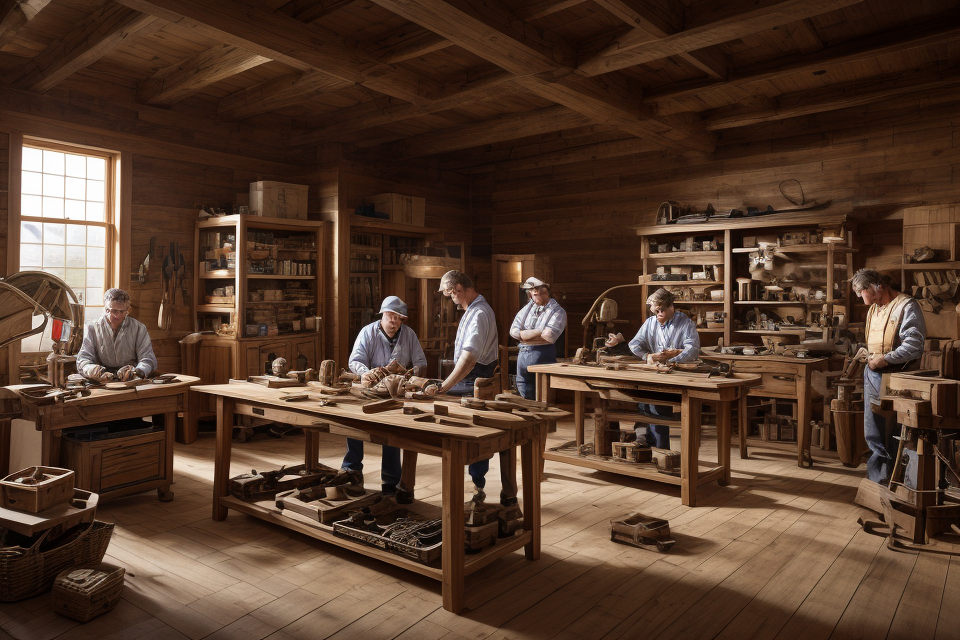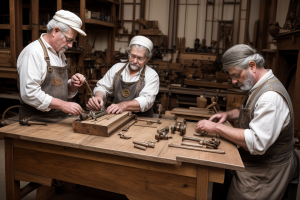
Craftsmanship refers to the skill and artistry that goes into creating a product or delivering a service. It encompasses attention to detail, precision, and the ability to bring a vision to life. Good craftsmanship means going above and beyond what is expected, putting in the extra effort to create something exceptional. It is about taking pride in one’s work and striving for perfection. In today’s world, where mass production and automation reign supreme, good craftsmanship is a rare and valuable commodity. This article will explore what good craftsmanship means, its importance, and how it can be achieved.
What is Craftsmanship?
A Definition
Craftsmanship can be defined as the combination of skill, expertise, and attention to detail that goes into creating a high-quality product or service. It involves a deep understanding of the materials and techniques used in the creation process, as well as a commitment to excellence in every aspect of the work.
Craftsmanship as Skill and Expertise
Craftsmanship is first and foremost about possessing the necessary skills and expertise to create a product or provide a service that meets the highest standards of quality. This requires a deep understanding of the materials and techniques used in the creation process, as well as a willingness to constantly learn and improve one’s skills.
Craftsmanship as Attention to Detail
In addition to possessing the necessary skills and expertise, craftsmanship also requires a keen attention to detail. This means paying close attention to every aspect of the creation process, from the initial design to the final product, in order to ensure that every detail is perfect. This attention to detail is what sets craftsmanship apart from other forms of workmanship and is what allows craftsmen to create products and services that are truly exceptional.
The Importance of Craftsmanship
The Value of Craftsmanship in the Modern World
Economic Value
In today’s fast-paced and globalized economy, craftsmanship continues to hold significant economic value. High-quality handmade products often command premium prices, as consumers are willing to pay for the unique craftsmanship, attention to detail, and superior quality that sets them apart from mass-produced items. The rise of artisanal and handmade products has created new job opportunities and businesses, contributing to economic growth and job creation in many regions.
Cultural and Historical Significance
Craftsmanship also holds cultural and historical significance, as it is deeply rooted in the traditions and customs of various societies. Many crafts have been passed down through generations, preserving the cultural heritage and knowledge of a particular region or community. These crafts often reflect the values, beliefs, and artistic expressions of the people who practice them, making them an essential part of a community’s identity and sense of place. Additionally, many historical and cultural landmarks, such as architectural structures and works of art, are a testament to the skill and craftsmanship of previous generations, providing a connection to the past and inspiring future generations to continue honing their craft.
Elements of Good Craftsmanship
Quality Materials
The Role of Quality Materials in Craftsmanship
The use of quality materials is an essential element of good craftsmanship. The materials used in a project play a crucial role in determining the final outcome and overall quality of the work. When quality materials are used, they not only enhance the durability and longevity of the product but also contribute to its aesthetic appeal. The quality of materials used can also impact the reputation of the craftsman and their work. Therefore, it is essential to ensure that only the best quality materials are used in any craftsmanship project.
Examples of High-Quality Materials
- Wood: High-quality wood is a common material used in many craftsmanship projects. The type of wood used can greatly impact the final product’s durability and appearance. For example, hardwoods such as oak and maple are known for their strength and resistance to wear and tear, making them ideal for furniture and flooring.
- Stone: Stone is another material that is often used in craftsmanship projects. Natural stone such as marble and granite are prized for their beauty and durability. These materials are often used in construction and can be used to create stunning countertops, flooring, and other decorative elements.
- Metal: Metals such as brass, copper, and stainless steel are also commonly used in craftsmanship projects. These materials are known for their strength and resistance to corrosion, making them ideal for use in items such as door handles, railings, and kitchenware.
- Fabric: High-quality fabrics such as silk, wool, and cotton are also used in craftsmanship projects. These materials are often used to create clothing, upholstery, and other textile items. The quality of the fabric can greatly impact the final product’s durability and aesthetic appeal.
Overall, the use of quality materials is a critical element of good craftsmanship. Craftsmen must carefully select and use only the best materials to ensure that their work meets the highest standards of excellence.
Attention to Detail
The Importance of Attention to Detail
Attention to detail is a critical element of good craftsmanship. It involves paying close attention to every aspect of the work, including the smallest details, in order to produce a high-quality final product. This level of precision and care is essential in ensuring that the end result meets the desired standards of excellence.
Examples of Attention to Detail in Craftsmanship
One example of attention to detail in craftsmanship can be seen in the art of woodworking. In this field, craftsmen pay close attention to the grain of the wood, the shape of the pieces, and the overall aesthetic of the finished product. This attention to detail can be seen in the intricate patterns and designs that are carved into the wood, as well as in the smoothness of the finish.
Another example of attention to detail can be found in the field of jewelry making. In this field, craftsmen pay close attention to every aspect of the piece, from the size and shape of the stones to the metal used to create the setting. This attention to detail ensures that the final product is not only beautiful but also durable and long-lasting.
In conclusion, attention to detail is a crucial element of good craftsmanship. It involves paying close attention to every aspect of the work, no matter how small, in order to produce a high-quality final product that meets the desired standards of excellence. Whether it’s in woodworking, jewelry making, or any other field, attention to detail is what sets great craftsmen apart from the rest.
Precision and Accuracy
The Role of Precision and Accuracy in Craftsmanship
Precision and accuracy are crucial elements in craftsmanship. They define the level of excellence that a craftsman aspires to achieve in their work. Precision refers to the degree of exactness or correctness of a craftsman’s work, while accuracy refers to the conformity of the work to a specific standard or design. Both precision and accuracy are essential in ensuring that the final product meets the desired quality and specifications.
Examples of Precision and Accuracy in Craftsmanship
One example of precision and accuracy in craftsmanship is the work of a watchmaker. A watchmaker must be precise and accurate in their work to ensure that the movement of the watch is precise and accurate. A watch that is not precise and accurate will not keep time accurately, and this can be frustrating for the user.
Another example of precision and accuracy in craftsmanship is the work of a surgeon. A surgeon must be precise and accurate in their work to ensure that the surgery is successful and the patient recovers quickly. A surgeon who is not precise and accurate in their work can cause harm to the patient, which can have serious consequences.
In conclusion, precision and accuracy are crucial elements in craftsmanship. They define the level of excellence that a craftsman aspires to achieve in their work. A craftsman who is precise and accurate in their work will produce a final product that meets the desired quality and specifications.
Creativity and Innovation
The Role of Creativity and Innovation in Craftsmanship
In any field of work, creativity and innovation play a crucial role in pushing the boundaries of what is possible and achieving excellence in craftsmanship. Creativity is the ability to generate new ideas and think outside the box, while innovation is the process of implementing those ideas to create something new or improve upon existing methods. In craftsmanship, both creativity and innovation are essential in finding unique solutions to problems and creating works of exceptional quality.
Examples of Creativity and Innovation in Craftsmanship
Throughout history, there have been countless examples of creativity and innovation in craftsmanship. For instance, the ancient Greeks used their knowledge of mathematics and geometry to create intricate sculptures and structures that still inspire awe today. Similarly, the Gothic architects of the Middle Ages used innovative techniques such as ribbed vaults and pointed arches to create soaring cathedrals that were both beautiful and structurally sound.
In more recent times, there have been many examples of creativity and innovation in craftsmanship, from the artisans who created the famous Stradivarius violins to the engineers who designed the world’s most advanced machinery. For example, the Stradivarius violins were famous for their unique sound quality, which was attributed to the innovative techniques used by Stradivari and his contemporaries in crafting the instruments. Similarly, modern engineers use computer-aided design and simulation tools to innovate and create cutting-edge machines and devices.
In conclusion, creativity and innovation are essential elements of good craftsmanship, as they allow artisans and professionals to push the boundaries of what is possible and create works of exceptional quality. Throughout history, there have been countless examples of creativity and innovation in craftsmanship, from ancient Greece to modern times, that continue to inspire and awe us today.
Examples of Good Craftsmanship
Artisanal Products
Pottery
Pottery is one of the oldest forms of artisanal products that have been made for centuries. The process of making pottery involves shaping and firing clay to create various items such as vessels, figurines, and decorative objects. Good pottery is defined by its durability, functionality, and aesthetic appeal. The quality of the clay, the skill of the potter, and the firing process all play a crucial role in determining the final product’s quality. A good pottery piece should be well-crafted, with smooth edges, no cracks, and a glaze that enhances its visual appeal.
Woodworking
Woodworking is another ancient art form that involves creating various items such as furniture, decorative objects, and tools using wood as the primary material. Good woodworking is characterized by its precision, durability, and aesthetic appeal. The quality of the wood, the skill of the woodworker, and the tools used all play a crucial role in determining the final product’s quality. A good woodworking piece should be well-crafted, with smooth edges, no cracks, and a finish that enhances its visual appeal.
Metalwork
Metalwork is a craft that involves creating various items such as jewelry, tools, and decorative objects using metal as the primary material. Good metalwork is characterized by its durability, functionality, and aesthetic appeal. The quality of the metal, the skill of the metalworker, and the tools used all play a crucial role in determining the final product’s quality. A good metalwork piece should be well-crafted, with smooth edges, no cracks, and a finish that enhances its visual appeal.
In conclusion, artisanal products such as pottery, woodworking, and metalwork require a high level of skill, creativity, and attention to detail to produce items of excellent quality. The final product’s quality is determined by various factors such as the quality of the materials used, the skill of the craftsperson, and the tools and techniques employed. A good artisanal product should be well-crafted, functional, and visually appealing, showcasing the craftsperson’s mastery of their craft.
Architecture
Historic Buildings
Historic buildings serve as a testament to the art of craftsmanship. These structures have stood the test of time, showcasing the skills of architects and builders who came before us. One example of this is the Gothic cathedrals of Europe, such as Notre-Dame in Paris, France. These buildings were constructed over many years, using only the most basic tools and materials. Despite this, they have stood for centuries, showcasing the attention to detail and skill of the craftsmen who built them.
Modern Architecture
Modern architecture also exemplifies the art of craftsmanship. Many modern buildings, such as the Guggenheim Museum in Bilbao, Spain, are known for their striking designs and innovative use of materials. The building’s curved shape, made of titanium and glass, was designed to catch the eye and draw people in. The use of cutting-edge materials and construction techniques, combined with a focus on aesthetic beauty, makes the Guggenheim Museum a prime example of modern craftsmanship.
Design and Fashion
Luxury Goods
Luxury goods have long been associated with high-quality craftsmanship. These goods are often handmade and crafted with attention to detail, using premium materials that are sourced ethically and sustainably. The makers of luxury goods take pride in their work, and it shows in the final product. The attention to detail, the use of high-quality materials, and the skill and expertise of the craftsmen all contribute to the overall excellence of the product. Luxury goods are not just a status symbol, but a representation of the art of craftsmanship.
Sustainable Fashion
Sustainable fashion is another area where good craftsmanship is highly valued. This approach to fashion prioritizes the use of environmentally friendly materials and production methods, while also creating high-quality, long-lasting products. Sustainable fashion designers and brands are committed to reducing waste and minimizing their impact on the environment, while still creating beautiful and functional garments. This requires a high level of craftsmanship, as designers must work with challenging materials and construction techniques to create products that are both stylish and sustainable. By valuing craftsmanship in sustainable fashion, designers are able to create products that are not only beautiful and functional, but also environmentally responsible.
The Future of Craftsmanship
Challenges and Opportunities
The Impact of Technology on Craftsmanship
- The increasing use of technology in various industries has brought about both challenges and opportunities for craftsmanship.
- On one hand, technology has made it possible to produce goods faster and more efficiently, which can threaten the traditional methods of craftsmanship.
- However, technology can also be used to enhance and preserve traditional craftsmanship techniques, by providing new tools and methods for craftsmen to use.
- For example, 3D printing technology has been used to reproduce intricate details of historical artifacts, helping to preserve them for future generations.
- Furthermore, technology has opened up new possibilities for collaboration between craftsmen and designers, allowing for the creation of innovative and unique products.
The Future of Sustainable Craftsmanship
- Sustainability is becoming an increasingly important factor in the world of craftsmanship, as consumers become more conscious of the environmental impact of their purchases.
- Craftsmen are facing challenges in finding sustainable materials and methods to use in their work, as well as in reducing waste and energy consumption.
- However, there are also opportunities for craftsmen to lead the way in sustainable practices, by experimenting with new materials and methods, and by promoting the value of sustainability to consumers.
- For example, some craftsmen are using recycled materials or renewable energy sources in their work, while others are collaborating with scientists to develop new, sustainable materials.
- In addition, craftsmen can play a role in educating consumers about the importance of sustainability, and in promoting the value of handmade and locally-produced goods.
The Importance of Preserving Craftsmanship
The Role of Education in Preserving Craftsmanship
In order to preserve craftsmanship, it is crucial to educate future generations on the value and importance of this traditional skill set. This can be achieved through incorporating craftsmanship education into school curriculums, offering vocational training programs, and providing apprenticeships with experienced craftsmen. By exposing young individuals to the art of craftsmanship, they can develop a deep appreciation for the time, effort, and dedication required to create high-quality, handcrafted items.
The Role of Government and Private Industry in Preserving Craftsmanship
Governments and private industry also play a vital role in preserving craftsmanship. They can do this by supporting and promoting craftsmanship through policies and initiatives that encourage the development and preservation of traditional skills. For example, providing financial incentives for businesses that prioritize craftsmanship in their products, or implementing programs that support the preservation of endangered crafts. Additionally, recognizing and celebrating the work of skilled craftsmen through awards and recognition can help to elevate the status of craftsmanship and inspire others to pursue this path.
FAQs
1. What is good craftsmanship?
Good craftsmanship refers to the level of skill, expertise, and attention to detail exhibited in the creation of a product or service. It involves a dedication to producing high-quality work that meets or exceeds the expectations of the customer or client. Good craftsmanship often involves a combination of technical knowledge, artistic ability, and practical experience.
2. How can I develop good craftsmanship?
Developing good craftsmanship requires a commitment to learning and improving your skills. This can involve seeking out training and education, practicing your craft regularly, and seeking feedback from others. It’s also important to have a passion for your work and a desire to produce the best possible results.
3. What are some examples of good craftsmanship?
There are many examples of good craftsmanship across a wide range of industries, from fine art and jewelry making to furniture making and automobile repair. In general, good craftsmanship is characterized by a high level of attention to detail, a commitment to using the best available materials, and a focus on producing work that is both functional and aesthetically pleasing.
4. Why is good craftsmanship important?
Good craftsmanship is important because it produces high-quality products and services that meet the needs and expectations of customers and clients. It also helps to ensure that products and services are safe and reliable, which can be particularly important in industries such as healthcare and aviation. In addition, good craftsmanship can help to enhance the reputation of a business or individual, as it is often associated with quality and attention to detail.
5. How can I recognize good craftsmanship?
Good craftsmanship is often characterized by a high level of attention to detail, a commitment to using the best available materials, and a focus on producing work that is both functional and aesthetically pleasing. In addition, good craftsmanship may be accompanied by a commitment to customer service and a willingness to go above and beyond to meet the needs of the customer or client. If you’re unsure whether a product or service demonstrates good craftsmanship, it may be helpful to seek out the opinions of others or to research the reputation of the business or individual producing the product or service.







